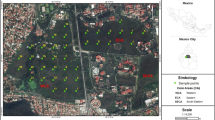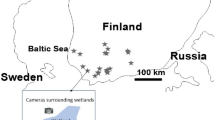Abstract
Although the raccoon dog Nyctereutes procyonoides has a wide global distribution, little is known about its population in Vietnam. The species is considered rare in Vietnam, and few records have been published since 2004, although it is worth noting that all of these records were wildlife trade observations or anecdotal reports. Here, we report raccoon dogs recorded in the illegal wildlife trade via Facebook monitoring from January to December 2020, rescued animals documented in the Nghe An province caught by a hunter in August 2020, and camera trap records of the species detected in Pu Mat National Park in May and July 2021. Our camera trap recordings provide evidence of a southern range extension for this species in Vietnam and represent the first documented occurrence of raccoon dogs captured in situ by camera traps within the country.


Similar content being viewed by others
Data availability
The data that support the findings of this study are available from the corresponding author, [Thong Van Pham], upon reasonable request.
References
Asahara M, Chang C H, Kimura J, Son NT, Takai M (2015) Re-examination of the fossil raccoon dog (Nyctereutes procyonoides) from the Penghu channel, Taiwan, and an age estimation of the Penghu fauna. Anthropol Sci 123(3):177–184. https://doi.org/10.1537/ase.150710
Aung TT (2020) Facebook purges ads for illegal wildlife in Southeast Asia as online trade surges. Reuters. Retrieved from https://www.reuters.com/article/us-myanmar-wildlife-idUSKCN2520C3. Accessed 6 Aug 2021
Drygala F (2009) Space use pattern, dispersal and social organisation of the raccoon dog (Nyctereutes procyonoides GRAY, 1834) an invasive, alien canid in Central Europe. Dissertation, Technische Universität Dresden, Dresden
Drygala F, Korablev N, Ansorge H, Fickel J, Isomursu M, Elmeros M, Frantz AC (2016) Homogenous population genetic structure of the non-native raccoon dog (Nyctereutes procyonoides) in Europe as a result of rapid population expansion. PLoS One 11(4):e0153098
Duscher T, Hodžić A, Glawischnig W, Duscher GG (2017) The raccoon dog (Nyctereutes procyonoides) and the raccoon (Procyon lotor)—their role and impact of maintaining and transmitting zoonotic diseases in Austria, Central Europe. Parasitol Res 116:1411–1416
Hirasawa M, Kanda E, Takatsuki S (2006) Seasonal food habits of the raccoon dog at a western suburb of Tokyo. Mammal Study 31(1):9–14
Hoffmann M, Abramov A, Duc HM, Long B, Nguyen A, Son NT, Rawson B, Timmins R, Van Bang T, Willcox D (2019) The status of wild canids (Canidae, Carnivora) in Vietnam. J Threat Taxa 11:13951–13959
Hong Y, Kim KS, Kimura J, Kauhala K, Voloshina I, Goncharuk MS, Yu L, Zhang Y, Sashika M, Lee H (2018) Genetic diversity and population structure of East Asian raccoon dog (Nyctereutes procyonoides): genetic features in central and marginal populations. Zool Sci 35:249–259
Kang JG, Chae JB, Cho YK, Jo YS, Shin NS, Lee H, Chae JS (2018) Molecular detection of Anaplasma, Bartonella, and Borrelia theileri in raccoon dogs (Nyctereutes procyonoides) in Korea. Am J Trop Med Hyg 98(4):1061–1068
Kauhala K, Auniola M (2001) Diet of raccoon dogs in summer in the Finnish archipelago. Ecography 24(2):151–156
Kauhala K, Auttila M (2010) Habitat preferences of the native badger and the invasive raccoon dog in southern Finland. Acta Theriol 55(3):231–240
Kauhala K, Kowalczyk R (2011) Invasion of the raccoon dog Nyctereutes procyonoides in Europe: history of colonization, features behind its success, and threats to native fauna. Curr Zool 57(5):584–598
Kauhala K, Laukkanen P, von Rége I (1998) Summer food composition and food niche overlap of the raccoon dog, red fox and badger in Finland. Ecography 21(5):457–463
Kauhala K, Saeki M (2016) Nyctereutes procyonoides. The IUCN Red List of Threatened Species E.T14925A85658776. https://doi.org/10.2305/IUCN.UK.2016-1.RLTS.T14925A85658776.en. Accessed 31 May 2021
Kim S, Park S, Lee H, Oshida T, Kimura J, Kim Y, Nguyen S, Sashika M, Min M (2013) Phylogeography of Korean raccoon dogs: implications of peripheral isolation of a forest mammal in East Asia. J Zool 290(3):225–235
Lavrov NP (1971) Results of raccoon dog introductions in different parts of the Soviet Union. Trudy Kafedry Biologii MGZPI 29:101–160 (In Russian)
Nghia NX, Dat NT, Dang NX, Cuong TX, Tuan VCA (2020) Current status of Asian elephant population Elephas maximus in Pumat National Park Region, Nghe An Province. Acad J Biol 42(2):55–64
Oanh DC (2004) Study and conservation activities on saola (Pseudoryx nghetinhensis) in Pu Mat National Park from 1993 to 2003. Rediscovering the saola [Workshop Proceeding] 45
Paulauskas A, Griciuviene L, Radzijevskaja J, Gedminas V (2016) Genetic characterization of the raccoon dog (Nyctereutes procyonoides), an alien species in the Baltic region. Turk Zool Derg 40(6):933–943
Pham TV, Luu VQ, Tien TV, Leprince B, Khanh LTT, Luiselli L (2019) Longitudinal monitoring of turtle trade through Facebook in Vietnam. Herpetol J 29(1):48–56
Süld K, Valdmann H, Laurimaa L, Soe E, Davison J, Saarma U (2014) An invasive vector of zoonotic disease sustained by anthropogenic resources: the raccoon dog in Northern Europe. PLoS ONE 9(5):e96358
Sutor A, Schwarz S, Conraths FJ (2014) The biological potential of the raccoon dog (Nyctereutes procyonoides, Gray 1834) as an invasive species in Europe—new risks for disease spread? Acta Theriol 59(1):49–59
Trinh MT (2022) Monitoring wildlife trade of small carnivores in Vietnam through Facebook [Data]. Retrieved from https://accounts.osf.io/login?service=https://osf.io/26s57/. Accessed 4 May 2022
Acknowledgements
We would like to thank Nguyen Sy Quoc and Vi Van Dinh and Dang Thanh Tuan who have accompany the researcher to interview the hunter and approach the Pu Mat staff to get data. The illegal wildlife trade online survey was funded by Wild Planet Trust.
Author information
Authors and Affiliations
Contributions
Study conception, MTT, TPV, TVN, MVN, TCAV, and NTN; data analysis and writing, TPV, RG, LNC, TVN, MTTD, and DW; administrative and research support, NTN, LTN, CXT, and TNV.
Corresponding author
Ethics declarations
Conflict of interest
The authors declare no competing interests.
Additional information
Publisher's Note
Springer Nature remains neutral with regard to jurisdictional claims in published maps and institutional affiliations.
Rights and permissions
Springer Nature or its licensor (e.g. a society or other partner) holds exclusive rights to this article under a publishing agreement with the author(s) or other rightsholder(s); author self-archiving of the accepted manuscript version of this article is solely governed by the terms of such publishing agreement and applicable law.
About this article
Cite this article
Van Pham, T., Trinh, M.T., Gray, R.J. et al. Southern extension of raccoon dog Nyctereutes procyonoides (Mammalia: Carnivora: Canidae) range in Vietnam with comments on its conservation status in the country. Eur J Wildl Res 69, 22 (2023). https://doi.org/10.1007/s10344-023-01653-7
Received:
Revised:
Accepted:
Published:
DOI: https://doi.org/10.1007/s10344-023-01653-7




